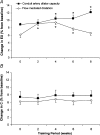Time course of change in vasodilator function and capacity in response to exercise training in humans
- PMID: 18755749
- PMCID: PMC2614057
- DOI: 10.1113/jphysiol.2008.158014
Time course of change in vasodilator function and capacity in response to exercise training in humans
Abstract
Studies of the impact of exercise training on arterial adaptation in healthy subjects have produced disparate results. It is possible that some studies failed to detect changes because functional and structural adaptations follow a different time course and may therefore not be detected at discrete time points. To gain insight into the time course of training-induced changes in artery function and structure, we examined conduit artery flow mediated dilatation (FMD), an index of nitric oxide (NO)-mediated artery function, and conduit dilator capacity (DC), a surrogate marker for arterial remodelling, in the brachial and popliteal arteries of 13 healthy male subjects (21.6 +/- 0.6 years) and seven non-active controls (22.8 +/- 0.2 years) studied at 2-week intervals across an 8-week cycle and treadmill exercise training programme. Brachial and popliteal artery FMD and DC did not change in control subjects at any time point. FMD increased from baseline (5.9 +/- 0.5%) at weeks 2 and 4 (9.1 +/- 0.6, 8.5 +/- 0.6%, respectively, P < 0.01), but returned towards baseline levels again by week 8 (6.9 +/- 0.7%). In contrast, brachial artery DC progressively increased from baseline (8.1 +/- 0.4%) at weeks 2, 4, 6 and 8 (9.2 +/- 0.6, 9.9 +/- 0.6, 10.0 +/- 0.5, 10.5 +/- 0.8%, P < 0.05). Similarly, popliteal artery FMD increased from baseline (6.2 +/- 0.7%) at weeks 2, 4 and 6 (9.1 +/- 0.6, 9.5 +/- 0.6, 7.8 +/- 0.5%, respectively, P < 0.05), but decreased again by week 8 (6.5 +/- 0.6%), whereas popliteal DC progressively increased from baseline (8.9 +/- 0.4%) at week 4 and 8 (10.5 +/- 0.7, 12.2 +/- 0.6%, respectively, P < 0.05). These data suggest that functional changes in conduit arteries occur rapidly and precede arterial remodelling in vivo. These data suggest that complimentary adaptations occur in arterial function and structure and future studies should adopt multiple time point assessments to comprehensively assess arterial adaptations to interventions such as exercise training in humans.
Figures


Similar articles
-
Impact of age, sex, and exercise on brachial artery flow-mediated dilatation.Am J Physiol Heart Circ Physiol. 2009 Sep;297(3):H1109-16. doi: 10.1152/ajpheart.00226.2009. Epub 2009 Jul 24. Am J Physiol Heart Circ Physiol. 2009. PMID: 19633208 Free PMC article.
-
Time-course of vascular adaptations during 8 weeks of exercise training in subjects with type 2 diabetes and middle-aged controls.Eur J Appl Physiol. 2015 Jan;115(1):187-96. doi: 10.1007/s00421-014-3006-7. Epub 2014 Sep 27. Eur J Appl Physiol. 2015. PMID: 25260246
-
Age and flow-mediated dilation: a comparison of dilatory responsiveness in the brachial and popliteal arteries.Am J Physiol Heart Circ Physiol. 2006 Dec;291(6):H3043-9. doi: 10.1152/ajpheart.00190.2006. Epub 2006 Jul 21. Am J Physiol Heart Circ Physiol. 2006. PMID: 16861699
-
Vascular adaptation in athletes: is there an 'athlete's artery'?Exp Physiol. 2012 Mar;97(3):295-304. doi: 10.1113/expphysiol.2011.058826. Epub 2011 Dec 16. Exp Physiol. 2012. PMID: 22179421 Review.
-
Impact of inactivity and exercise on the vasculature in humans.Eur J Appl Physiol. 2010 Mar;108(5):845-75. doi: 10.1007/s00421-009-1260-x. Epub 2009 Nov 27. Eur J Appl Physiol. 2010. PMID: 19943061 Free PMC article. Review.
Cited by
-
You get what you give: localized vascular changes are apparent following long-term exercise training.J Physiol. 2013 May 1;591(9):2243-4. doi: 10.1113/jphysiol.2013.253161. J Physiol. 2013. PMID: 23740885 Free PMC article. No abstract available.
-
Biological sex does not influence the peak cardiac output response to twelve weeks of sprint interval training.Sci Rep. 2023 Dec 27;13(1):22995. doi: 10.1038/s41598-023-50016-4. Sci Rep. 2023. PMID: 38151488 Free PMC article.
-
Assessment of flow-mediated dilation in humans: a methodological and physiological guideline.Am J Physiol Heart Circ Physiol. 2011 Jan;300(1):H2-12. doi: 10.1152/ajpheart.00471.2010. Epub 2010 Oct 15. Am J Physiol Heart Circ Physiol. 2011. PMID: 20952670 Free PMC article. Review.
-
Long-term exercise training does not alter brachial and femoral artery vasomotor function and endothelial phenotype in healthy pigs.Am J Physiol Heart Circ Physiol. 2010 Aug;299(2):H379-85. doi: 10.1152/ajpheart.00294.2010. Epub 2010 May 28. Am J Physiol Heart Circ Physiol. 2010. PMID: 20511414 Free PMC article.
-
Evaluation of Lower Limb Arteriovenous Diameters in Indoor Soccer Athletes: Arterial Doppler Ultrasound Study.Front Physiol. 2021 Jun 28;12:687613. doi: 10.3389/fphys.2021.687613. eCollection 2021. Front Physiol. 2021. PMID: 34262477 Free PMC article.
References
-
- Brown MD. Exercise and coronary vascular remodelling in the healthy heart. Exp Biol Med. 2003;88:645–658. - PubMed
-
- Clarkson P, Montgomery HE, Mullen MJ, Donald AE, Powe AJ, Bull T, Jubb M, World M, Deanfield JE. Exercise training enhances endothelial function in young men. J Am Coll Cardiol. 1999;33:1379–1385. - PubMed
-
- Conway J. A vascular abnormality in hypertesnion – a study of blood flow in the forearm. Circulation. 1963;27:520–529. - PubMed
-
- Corretti MC, Anderson TJ, Benjamin EJ, Celermajer DS, Charbonneau F, Creager MA, Deanfield J, Drexer H, Gerhard-Herman M, Herrington D, Vallance P, Vogel R. Guidelines for the ultrasound assessment of flow-mediated vasodilation of the brachial artery. J Am Coll Cardiol. 2002;39:257–265. - PubMed
-
- Delp MD, Laughlin HM. Time course of enhanced endothelium-mediated dilation in aorta of trained rats. Med Sci Sports Exerc. 1997;29:1454–1461. - PubMed

